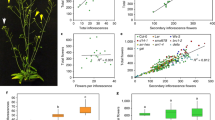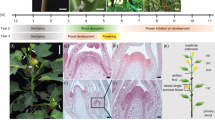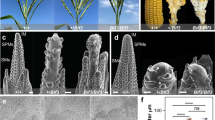Abstract
INDUCED homeotic floral mutants in Arabidopsis thaliana and Antirrhinum majus1–3 are used to investigate the molecular mechanisms that establish floral organ identity. Here we describe bicalyx, a naturally occurring homeotic floral variant in Clarkia concinna (Onagraceae) that replaces petals with sepal-like structures. Typical C. concinna flowers have four sepals, four tri-lobed, bright pink petals, four stamens and a four-part ovary. Bicalyx flowers appear to have eight sepals, no petals and wild-type stamens and ovary with no reduction in fertility. All bicalyx organs on a plant are alike and have no developmental abnormalities, in contrast to many of the homeotic phenotypes described4–7. Bicalyx demonstrates that a large morphological difference governed by a simple genetic change can become established in a natural plant population and suggests that even homeotic genes play a role in the evolution of morphological diversity in plants.
This is a preview of subscription content, access via your institution
Access options
Subscribe to this journal
Receive 51 print issues and online access
$199.00 per year
only $3.90 per issue
Buy this article
- Purchase on Springer Link
- Instant access to full article PDF
Prices may be subject to local taxes which are calculated during checkout
Similar content being viewed by others
References
Bowman, J. L., Smyth, D. R. & Meyerowitz, E. M. Development 112, 1–20 (1991).
Coen, E. S. & Meyerowitz, E. M. Nature 353, 31–37 (1991).
Schwarz-Sommer, Z., Huijser, P., Nacken, W., Saedler, H. & Sommer, H. Science 250, 931–936 (1990).
Komaki, M. K., Okada, K., Nishino, E. & Shimura, Y. Development 104, 195–203 (1988).
Bowman, J. L., Smyth, D. R. & Meyerowitz, E. M. Pl. Cell 1, 37–52 (1989).
Irish, V. F. & Sussex, I. M. Pl. Cell 2, 741–753 (1990).
Schultz, E. A., Pickett, F. S. & Haughn, G. W. Pl. Cell 3, 1221–1237 (1991).
Vasek, F. Evolution 18, 26–42 (1964).
Vasek, F. Evolution 20, 243–244 (1966).
van Tunen, A. J. & Angenent, G. C. Flowering Newslett. 12, 34–37 (1991).
Meyer, V. Bot. Rev. 32, 165–195 (1966).
Meyerowitz, E. M., Smyth, D. R. & Bowman, J. L. Development 106, 209–217 (1989).
Gustafsson, Å. Theor. appl. Genet 54, 241–248 (1979).
Gottlieb, L. D. Am. Nat. 123, 681–709 (1984).
Lewis, H. Am. Nat 107, 161–170 (1973).
Author information
Authors and Affiliations
Rights and permissions
About this article
Cite this article
Ford, V., Gottlieb, L. Bicalyx is a natural homeotic floral variant. Nature 358, 671–673 (1992). https://doi.org/10.1038/358671a0
Received:
Accepted:
Issue Date:
DOI: https://doi.org/10.1038/358671a0
This article is cited by
-
Floral visitation and reproductive traits of Stamenoid petals, a naturally occurring floral homeotic variant of Capsella bursa-pastoris (Brassicaceae)
Planta (2009)
-
Capsella as a model system to study the evolutionary relevance of floral homeotic mutants
Plant Systematics and Evolution (2006)
-
ABC model and floral evolution
Chinese Science Bulletin (2003)
-
Evolutionary conservation of angiosperm flower development at the molecular and genetic levels
Journal of Biosciences (1997)
Comments
By submitting a comment you agree to abide by our Terms and Community Guidelines. If you find something abusive or that does not comply with our terms or guidelines please flag it as inappropriate.



